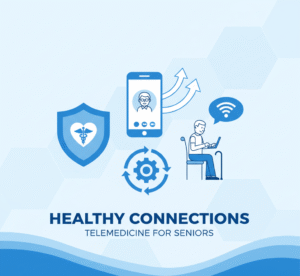“Attract more patients! Learn the essentials of designing a Pediatrics Website: kid-friendly design, easy navigation, SEO, and key features for growth.”
Choosing the right pediatrician for your child ranks high on crucial parenting decisions. Parents seek medical expertise, a comforting presence, a reassuring demeanor, and a genuine connection with their little ones. In today’s digital age, your website often serves as the initial point of contact, the virtual handshake that forms a first impression. Therefore, crafting a pediatric website that is both visually appealing and functionally robust is paramount to attracting new patients and fostering trust within your community. Let’s delve deeper into the key elements.
The Importance of a Kid-Friendly and Colorful Design
Stepping into a pediatrician’s office often feels like entering a world designed with children in mind. The walls might be adorned with playful murals, the waiting area might feature colorful toys and books, and the overall atmosphere aims to alleviate any anxieties a child (or their parent) might have. Your website needs to echo this welcoming sentiment in the digital realm.
A visually engaging website, adorned with a carefully chosen palette of cheerful colors and friendly, age-appropriate graphics, immediately communicates that your practice is centered around children. It creates a virtual environment that feels safe and inviting even before a family sets foot in your clinic. While prioritizing professional competence, parents are also subconsciously drawn to a site that exudes warmth and care. A thoughtfully curated color scheme – perhaps incorporating soothing blues and greens alongside energetic yellows and oranges – can evoke feelings of trust and positivity.
Consider the impact of imagery. Instead of purely clinical stock photos, consider incorporating gentle illustrations of animals, smiling children, or abstract playful patterns. Subtle animations, such as a gently waving hand or a softly bouncing graphic, can add a touch of whimsy without distraction. However, it’s crucial to strike a balance. While embracing a kid-friendly aesthetic, the website must also maintain professionalism, reassuring parents about the quality of medical care you provide. Overly cartoonish or cluttered designs can inadvertently detract from this sense of expertise. The key lies in a harmonious blend of approachability and authority. Consider how the design elements guide the eye and create a positive emotional response. Does it feel nurturing? Does it feel trustworthy? These are the questions to ask when shaping the visual identity of your online presence.
Creating an Intuitive and Easy-to-Navigate Site
Imagine a parent, perhaps juggling a fussy toddler and a mental checklist of questions, trying to quickly locate your office hours, understand your accepted insurance plans, or figure out how to schedule a well-child visit. If your website presents a confusing labyrinth of links, unclear labeling, or a frustratingly slow loading time, the likelihood of that parent abandoning your site in favor of a competitor increases significantly. An intuitive website design isn’t just a nicety; it’s a fundamental requirement for converting online visitors into actual patients.
This necessitates a clear and logical information architecture. Employ simple and consistently placed navigation menus. Use straightforward labels for your pages (e.g., “Our Doctors,” “Services,” “Appointments,” “Contact Us”). Ensure that critical information, such as your phone number, physical address, and hours of operation, is readily visible, ideally in the header or footer of every page. A prominent and easily identifiable call to action (CTA), such as a brightly colored “Book an Appointment” button, should be strategically placed on relevant pages.
Think from the perspective of a busy parent. What are the most common tasks they’ll want to accomplish on your website? Likely, it’s finding basic information, understanding your services, and scheduling an appointment. Make these actions as seamless as possible. A functional internal search bar can also be invaluable for users who know exactly what they want. Break down large blocks of text with clear headings, subheadings, bullet points, and concise paragraphs to improve readability. A well-structured website respects the visitor’s time and demonstrates a commitment to clear communication, ultimately fostering a positive user experience. Consider conducting user testing (even informally with friends or family) to identify any confusion or difficulty navigating your site.
Optimizing Your Website for Search Engines (SEO)
Having a visually stunning and user-friendly website is a significant first step, but it’s akin to opening a beautiful shop in an alleyway no one knows exists. This is where the strategic implementation of Search Engine Optimization (SEO) becomes crucial. SEO is the multifaceted process of enhancing your website’s visibility within the organic (non-paid) results of search engines like Google, Bing, and others.
When parents in your local area search for terms like “pediatrician near me,” “children’s doctor in [your city],” or “best kids’ clinic,” your goal is to have your website appear prominently among the top results. Effective SEO involves a blend of art and science, encompassing several interconnected elements:
- In-depth Keyword Research: This involves identifying the precise words and phrases your target audience (parents seeking pediatric care) actively uses in their online searches. Tools and techniques are employed to uncover high-volume, relevant keywords such as “[your city] pediatrician,” “childhood vaccinations,” “pediatric urgent care,” and condition-specific searches like “child with fever.” Understanding this search landscape is the foundation of a successful SEO strategy.
- Strategic On-Page Optimization: Once relevant keywords are identified, the next step is to thoughtfully integrate them into the content and structure of your website. This includes optimizing page titles (the text that appears in browser tabs and search results), meta descriptions (the summaries below the title in search results), headings (H1, H2, etc., used to structure content), the body text itself, image alt tags (descriptive text for images), and the URLs of your pages. The aim is to communicate clearly to search engines what each page is about.
- Robust Technical SEO: This focuses on the underlying technical health of your website, ensuring it’s easily crawlable and indexable by search engine bots. Key aspects include site speed (how quickly your pages load), mobile-friendliness (as discussed earlier), website architecture (how your pages are linked together), the presence of an XML sitemap (a file that helps search engines discover all your pages), and the proper use of robots.txt (a file that tells search engines which pages to crawl or not crawl). A technically sound website provides a solid foundation for SEO success.
- Effective Local SEO: Attracting local patients is paramount for a pediatric practice. Local SEO strategies optimize your online presence specifically for your geographic area. This includes fully optimizing your Google My Business (now Google Business Profile) listing with accurate information (name, address, phone number, hours), encouraging and managing online reviews, building local citations (mentions of your business on other relevant websites), and targeting local keywords in your content.
By implementing a comprehensive and well-executed SEO strategy, you can significantly increase the organic traffic to your website, meaning more parents actively searching for pediatric care in your area will find your practice through search engines. At Invigo Media, our specialized SEO services are meticulously crafted to elevate your pediatric practice’s online visibility, helping you connect with more families within your community and establish yourself as a trusted local provider. We stay abreast of the latest SEO best practices and algorithm updates to ensure your website remains competitive in the ever-evolving digital landscape.
Integrating Essential Features
A contemporary pediatric website transcends being just an online brochure; it needs to be a dynamic and functional tool that enhances the experience for both parents and your administrative team. Integrating essential features can streamline processes, provide greater convenience, and improve patient satisfaction. Let’s explore these features in greater depth:
- Seamless Responsive Design: As highlighted earlier, the pervasive use of smartphones and tablets for online browsing makes responsive design non-negotiable. A website that fluidly adapts its layout, images, and navigation to fit any screen size ensures a consistently positive user experience, regardless of the device a parent uses. This improves user satisfaction and positively influences your search engine rankings, as Google prioritizes mobile-friendly websites. Consider how frustrating it is to navigate a desktop-centric website on a small phone screen – the pinching, zooming, and awkward scrolling can quickly drive users away. Responsive design eliminates these frustrations.
- Convenient Online Appointment Scheduling: Empowering parents to book appointments through your website offers unparalleled convenience. This 24/7 accessibility can significantly reduce the volume of phone calls to your office, freeing your staff to focus on other crucial tasks. Online scheduling systems can often integrate with your existing practice management software, allowing real-time availability updates and automated confirmations. Think about the ease for a busy parent to schedule a sick visit at 10 PM after their child develops a fever, without waiting until the next morning to call.
- Secure Patient Portal Integration: A secure patient portal provides a centralized online hub for parents to access their child’s medical records (with appropriate security protocols), request prescription refills, view immunization records, and even communicate with your practice through secure messaging. This enhances transparency, empowers parents to be more involved in their child’s care, and can further reduce phone calls for routine requests. Ensuring HIPAA compliance is paramount when implementing a patient portal.
- Valuable Information Resources: Position your practice as a trusted source of information by providing readily accessible educational content. This could include articles on common childhood illnesses (e.g., managing colds, understanding ear infections), vaccination schedules and information, developmental milestones, nutrition tips, and safety advice. Well-written and informative content benefits parents and improves your website’s SEO by attracting users searching for these topics. Consider creating blog posts, downloadable guides, or even short video explainers.
- Personal “Meet the Doctors/Staff” Page: Building trust begins with familiarity. A dedicated page featuring your pediatricians and key staff members, complete with professional photos and brief, personable biographies, allows parents to connect with the individuals caring for their children. Highlighting their experience, qualifications, and even a little about their approach can foster a sense of comfort and confidence.
- Clear Contact Information and Location Details: Make contacting your practice unequivocally easy for parents. Prominently display your phone number, email address, and physical address on every page, ideally in the header and footer. Embedding an interactive map of your location can also be incredibly helpful for first-time visitors. Ensure your contact information is accurate and up-to-date.
The Power of Responsive Design
Let’s further illustrate the significance of responsive design. Picture a parent searching for a pediatrician on their smartphone while waiting at school or during a lunch break. Suppose your website stubbornly displays the full desktop version on a small screen. In that case, they’ll likely encounter a frustrating jumble of tiny text, overlapping elements, and a layout that requires constant pinching and zooming just to navigate. This clunky and inconvenient experience can immediately create a negative perception of your practice – if their website isn’t user-friendly, what about their patient care?
Conversely, a responsively designed website intelligently adapts to the dimensions of the screen it’s being viewed on. The layout will rearrange itself, text will be appropriately sized for readability, buttons will be large enough to tap easily, and navigation menus will often collapse into a mobile-friendly format. This ensures a smooth, intuitive, and enjoyable browsing experience, regardless of whether a parent uses a large desktop monitor, a mid-sized tablet, or a compact smartphone. Beyond user experience, Google also considers mobile-friendliness as a ranking factor in its search algorithm. Therefore, having a responsive design is not just about pleasing your visitors; it’s also about improving your website’s visibility in search results. It signals to users and search engines that you prioritize accessibility and a positive online interaction.
Boosting Patient Trust and Conversions
A professionally crafted, thoughtfully designed, and inherently user-friendly website is a powerful trust-building asset for your pediatric practice. When parents encounter an online presence that is polished, informative, and easy to navigate, it subconsciously communicates a sense of professionalism, attention to detail, and a commitment to providing a positive experience. This positive initial impression can significantly influence their decision-making when choosing a pediatrician for their child.
“Conversions,” in the context of your website, refer to the desired actions visitors take, ultimately leading to them becoming patients. These conversions can include:
- Booking an appointment: A clear and accessible online scheduling system facilitates this conversion.
- Fill out a contact form for inquiries or new patient registrations.
- Calling your office: Easily visible phone numbers encourage direct contact.
- Requesting more information: Through specific forms or email sign-ups.
A website that is easy to navigate ensures that potential patients can readily find the information they need to take these conversion actions. Strong and clear calls to action (CTAs), such as “Schedule Your Child’s Check-up Today!” or “Contact Us for More Information,” guide visitors towards these desired outcomes. Think of your website as your tireless 24/7 online representative. It’s perpetually available to provide essential information, address common queries, and guide prospective families on the following steps to connect with your practice. A well-optimized website attracts visitors and effectively nurtures them into becoming valued patients.
Why Choose Invigo Media for Your Pediatric Website?
At Invigo Media, we possess a deep understanding of the unique digital marketing needs of pediatric practices. We don’t offer generic web solutions; we specialize in web development services tailored specifically to create visually engaging, intuitively navigable, high-performing websites meticulously designed to attract and retain more patients for your practice.
We go beyond simply building aesthetically pleasing websites. We focus on crafting comprehensive online experiences that resonate with concerned parents and curious children. Our experienced designers, developers, and SEO specialists understand the critical importance of a kid-friendly yet professional design, seamless navigation that caters to busy parents, and robust SEO strategies that ensure your practice is easily discoverable online. We collaborate closely with you, taking the time to thoroughly understand your practice’s unique brand identity, your specific service offerings, and your overarching patient acquisition goals. This collaborative approach ensures that your website authentically reflects your values, your expertise, and the compassionate care you provide.
Our comprehensive web development services encompass:
- Bespoke Pediatric Website Design: We create custom website designs that are visually appealing, age-appropriate, and strategically aligned with your brand and target audience.
- Flawless Responsive Design Implementation: We ensure your website delivers an optimal viewing experience across all devices, from large desktop monitors to the smallest smartphones.
- Strategic SEO Optimization Integration: From the initial design and content creation phases, we build in SEO best practices to enhance your website’s visibility in search engine results.
- Seamless Integration of Essential Features: We expertly integrate functionalities such as user-friendly online appointment scheduling systems, secure patient portal links, and easily updatable information resource sections.
- Ongoing Website Support and Maintenance: We provide reliable continuing support and maintenance services to ensure your website remains secure, up-to-date, and optimized.
We are steadfastly committed to providing you with a website that looks exceptional and delivers tangible results. This website will help you connect with more families in your local community and solidify your position as a leading pediatric care provider.
Conclusion
Your pediatric practice’s website is more than just a digital address; it’s a dynamic and influential tool that plays a pivotal role in attracting new patients, fostering trust with current families, and streamlining your clinic’s overall communication and administrative processes. By prioritizing a website design that embraces a child-friendly aesthetic, ensures effortless navigation for busy parents, is strategically optimized for search engine visibility, and integrates essential, user-centric features, you can cultivate an online presence that truly reflects the exceptional quality of care you provide.
Are you ready to elevate your pediatric practice’s online presence and unlock its potential for patient acquisition and engagement? Reach out to Invigo Media today for a consultation. Let our expertise in web development services and results-driven SEO services guide you in designing and implementing a website that looks fantastic and effectively attracts more of the families you aim to serve. We’re here to help you make a lasting positive first impression online.
Frequently Asked Questions:
Q: Why is a colorful design essential for a pediatric website?
A: A colorful and playful design helps create a welcoming and child-friendly environment online, mirroring the atmosphere of a pediatric clinic. It can make children feel more comfortable and reassure parents that you cater to young patients.
Q: What is responsive design, and why is it necessary?
A: Responsive design ensures your website adapts seamlessly to different screen sizes (desktops, tablets, smartphones). It’s crucial because many parents will browse your website on their mobile devices, and a non-responsive site can lead to a poor user experience.
Q: How does SEO help my pediatric practice?
A: SEO (Search Engine Optimization) helps your website rank higher in search engine results for relevant keywords (e.g., “pediatrician near me”). This increases your online visibility, making it easier for potential patients in your area to find you.
Q: What are some essential features to include on a pediatric website?
A: Essential features include online appointment scheduling, clear contact information, a “Meet the Doctors/Staff” page, information resources for parents, and potentially integration with a patient portal.
Q: Can Invigo Media help with SEO for my pediatric website?
A: Yes! Invigo Media offers comprehensive SEO services to help pediatric practices improve online visibility and attract more local patients.
Q: What kind of web development services does Invigo Media offer?
A: Invigo Media provides various web development services, including custom pediatric website design, responsive design, feature integration (like online scheduling), and ongoing website maintenance and support.
Q: How can online appointment scheduling benefit my practice?
A: Online appointment scheduling offers convenience for parents, allowing them to book appointments at any time. It can also reduce the workload on your front office staff by minimizing phone calls.
Q: What should I include on the “Meet the Doctors/Staff” page?
A: Include photos of your pediatricians and staff, along with brief biographies highlighting their experience, qualifications, and approach to patient care. This helps build trust and familiarity.
Q: How important is website navigation?
A: Website navigation is essential. A straightforward and intuitive navigation makes it easy for parents to quickly find the information they need, leading to a better user experience and a higher likelihood of them contacting your practice.
Q: What kind of content should I include on my pediatric website?
A: Include information about your services, your team, your location, and contact details, appointment scheduling, and potentially educational content like articles on children’s health topics.
Q: How long does it take to build a pediatric website?
A: The timeline can vary depending on the complexity of the design and the features you want to include. After discussing your specific needs, we’ll provide a realistic timeline.
Q: Will my website be mobile-friendly if Invigo Media designs it?
A: Yes, all websites developed by Invigo Media are built with responsive design principles, ensuring they look and function perfectly on all devices, including smartphones and tablets.
Q: How do I get started with Invigo Media?
A: Simply contact us through our website or give us a call. We’ll be happy to discuss your needs and how our web development and SEO services can help your pediatric practice thrive online.
Q: What makes Invigo Media the best choice for a pediatric website?
A: We specialize in creating websites specifically for pediatric practices. We understand the unique needs of this sector and are dedicated to designing websites that are visually appealing, user-friendly, and effective in attracting new patients. Our combined web development and SEO services offer a comprehensive solution for your online presence.
Q: Can you integrate a patient portal into my new website?
A: Yes, we can integrate a secure patient portal into your website, allowing parents to access their child’s medical records, request refills, and communicate with your practice online, if you have such a system.
Q: What kind of ongoing support do you offer?
A: We offer ongoing support and maintenance packages to ensure your website functions smoothly and is up-to-date. These packages include technical support, content updates, and security monitoring.
Q: How do I know if my website is attracting new patients?
A: We can help you track key metrics, such as website traffic, contact form submissions, and online appointment bookings, to measure the effectiveness of your website in attracting new patients.
Q: Do you offer website redesign services if I already have a website?
A: We offer website redesign services to help you update and improve your existing website, attracting patients more effectively and enhancing user experience.
Q: What is local SEO, and why is it important for a pediatric practice?
A: Local SEO optimizes your online presence to attract local patients. This is crucial for a pediatric practice as parents typically search for services in their immediate area. It involves optimizing your Google My Business profile, local citations, and more.
Q: How can I build trust with parents through my website?
A: You can build trust by having a professional and well-designed website, providing clear information about your services and team, showcasing testimonials (with permission), and ensuring your contact information is easily accessible.
Q: What common mistakes should be avoided when designing a pediatric website?
A: Common mistakes include having a cluttered or confusing design, not being mobile-friendly, lacking clear calls to action, and not optimizing for search engines.
Q: Can you help me create content for my website?
A: Yes, we can assist with content creation to ensure your website is informative, engaging, and optimized for relevant keywords.
Q: What is the first step in getting a new pediatric website designed by Invigo Media?
A: The first step is to contact us for a consultation. We’ll discuss your needs and goals and answer any questions you may have.













